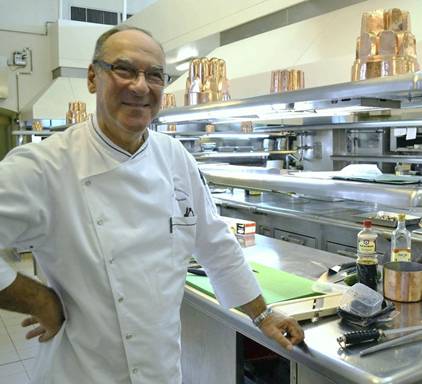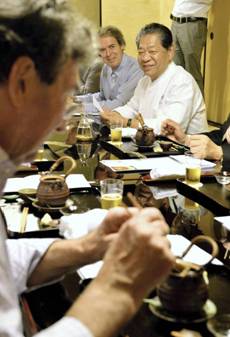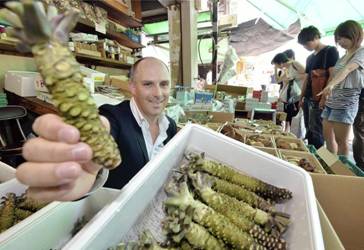Japan’s food wins global admiration
Posted on November 22, 2013 On The Japan News by The Yomiuri Shimbun
http://the-japan-news.com/news/article/0000771004

The Yomiuri Shimbun
Elysee presidential palace chef Bernard Vaussion talks about washoku
At his kitchen in Paris. He said shoyu is always at the ready in his kitchen.
The Yomiuri Shimbun
The popularity of washoku traditional Japanese cuisine—from everyday dishes to luxurious kaiseki ryori—has spread to big cities such as New York and Paris, influencing the daily diets of residents there. With washoku expected to be added to the UNESCO Intangible Cultural Heritage list in December, The Yomiuri Shimbun is examining the cuisine through the eyes, and palates, of non-Japanese people. The following are the last installments in a four-part series on washoku.
PARIS—In 2010, “the gastronomic meal of the French” was registered as a world intangible heritage by UNESCO. In a country that is home to such an esteemed designation, however, washoku appears as a frequent choice on the menu of the Elysee presidential palace.
Palace chef Bernard Vaussion serves tempura at cocktail parties from time to time.
“I often use shoyu [soy sauce] for my original sauce,” he said.
At President Francois Hollande’s request, Vaussion sometimes prepares nori-maki sushi rolls with lobster or salmon at the president’s family dinners.
“French cuisine was greatly influenced by Japanese cuisine. How sashimi is served especially teaches me a lot,” Vaussion said. “At a glance, washoku seems simple, but it is actually elaborate with invisible details. All the dishes are also made by placing great value on the freshness of the ingredients. It blew my mind as a professional chef.”
Not only chefs, but also those who eat washoku rate it highly. Journalist Michael Booth traveled across Japan with his family to sample various Japanese foods, such as ramen, chanko nabe stew and kaiseki ryori. His book about the experience, “Sushi and Beyond,” was published in Japanese by Akishobo this spring as “Eikoku Ikka, Nihon o Taberu” (A British family eats across Japan).
According to Booth, washoku has two main appeals. One is “a sense of the season.”
“When matsutake mushrooms are in season, Japanese people feel the arrival of autumn. They sense the changing of the four seasons through food,” he said.

The Yomiuri Shimbun
Owner Yoshihiro Murata explains washoku to a group of
chefs from Belgium at his Kukunoi restaurant in Kyoto.

The Yomiuri Shimbun
British journalist Michael Booth holds wasabi during a visit to the Tsukiji Central Market in Tokyo to do a report on Japanese food culture.
Another appeal is “diversity.” Japan’s land stretches from north to south, and geographical features help each region develop unique ingredients and cuisines. One can eat kyo-yasai vegetables grown exclusively in Kyoto or yuba tofu skin in Kyoto, kushikatsu deep-fried skewered meat in Osaka and umibudo (seaweed) in Okinawa, for example.
Booth said another notable characteristic is that Japan has many washoku restaurants specializing in one particular kind of dish such as yakitori skewered chicken or eel.
“Japanese chefs are proud of their skills,” he said. “Washoku does deserve a world intangible heritage designation, but Japanese people don’t realize the appeal of their own food. Japanese should rediscover the attractions of washoku.”
Washoku in shadows at home
Although washoku has caught global attention, Japanese people today are consuming less of this traditional cuisine.
“Western food dominates dishes in Japanese households, and washoku has become less available at the dining table nowadays. If this goes on, washoku will become a heritage from the past,” said Yoshihiro Murata, owner of the famed Kyoto restaurant Kikunoi and chairman of the Japanese Culinary Academy.
Murata began promoting dietary education in order to teach Japanese food culture to the next generation by showing children the charm of washoku. He studies washoku scientifically and nurtures chefs by cooperating with industry, government and academic bodies.
Murata said that unlike overseas cuisines, washoku allows chefs to produce dishes using various ingredients with the help of umami from dashi broth, while keeping the calories low.
In Japan, people eat zoni soup with mochi on New Year’s holidays and hold imoni potato-and-meat soup parties outdoor in autumn mainly in the Tohoku region. Washoku plays an important role in connecting communities and families.
“To preserve washoku means to preserve traditional events in regions and communities,” Murata said.
Murata has traveled overseas to introduce washoku, hoping to get it recognized as a UNESCO world intangible heritage.
“I hope the recognition will inspire each Japanese to think more deeply about their own food culture,” Murata said.
Original Article: The Japan Times by Yomiuri Shimbun
http://the-japan-news.com/news/article/0000771004
